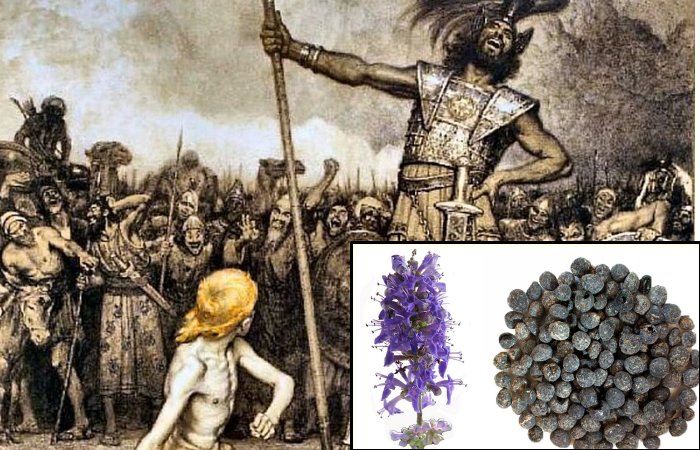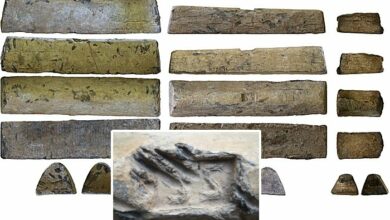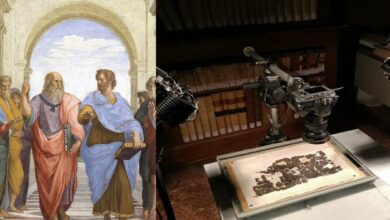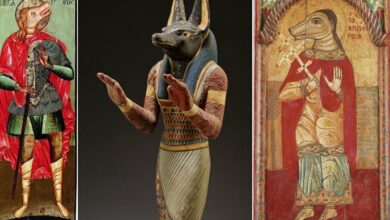Reconstructed Plants From Biblical Goliath Hometown Shed Light On Philistine Rituals

Conny Waters – AncientPages.com – The mysterious Philistine culture that thrived during the Iron Age (around 1200–604 BCE) significantly impacted the cultural history, farming practices, and eating habits of the southern Levant.
Over 25 years of digging at Tell es-Safi/Gath in central Israel, believed to be the Biblical Gath of the Philistines and Goliath’s hometown, has given us an unparalleled glimpse into this ancient civilization’s world. However, there are still some questions scientists cannot answer.
David and Goliath, a color lithograph by Osmar Schindler (c. 1888). Credit: Public Domain
For example, despite having a wealth of information about the ancient Philistine people, the details of their religious customs and gods have always been somewhat elusive.
A group from Bar-Ilan University in Israel, led by Professor Aren Maeir (an archaeologist) and Prof. Ehud Weiss (an expert in archaeobotany), has been diligently working on the meticulous excavation project at the temple area in Gath’s lower city. Their primary focus has been to reconstruct and understand the plant types integral to Philistine rituals.
Uncovering many plants in two unearthed temples at the site has shed new light on Philistine religious rituals and beliefs. This includes the types of food ingredients they used in their temple when they held their ceremonies and what plants they used for temple decoration. According to the research team, it is an unprecedented peek into the Philistine culture we have never had before.
By thoroughly studying and applying both quantitative and qualitative analysis to the variety of plants used, their harvest timing, offering methods, and possible symbolic meanings, researchers have gained a deeper understanding of the Philistine’s spiritual practices.
Flowering crown daisy. Credit: Dr. Suembikya Frumin
“One of the most significant findings is the identification of earliest known ritual uses of several Mediterranean plants, such as the lilac chaste tree (Vitex agnus-castus), crown daisy (Glebionis coronaria), and silvery scabious (Lomelosia argentea).”
These widespread Mediterranean plants connect Philistines with cultic rituals, mythology, and paraphernalia related to early Greek deities, such as Hera, Artemis, Demeter, and Asclepios. In addition, plants with psychoactive and medicinal properties in the Philistine temples reveal their use for cultic activities. The study revealed that the Philistine religion relied on the magic and power of nature, such as running water and seasonality, aspects that influence human health and life,” Dr. Suembikya Frumin, manager of the Archaeobotany Laboratory at Bar-Ilan University and the study’s lead researcher said.
Left: Chaste tree flower. Credit: Dr. Suembikya Frumin – Right: Fruits of chaste tree in the temple—fossil fruits of the chaste tree, as found in the inner room of the temple in Tell es-Safi/Gath, lower city. Credit: Dr. Suembikya Frumin
In addition, examining seeds and fruits from the temples offered a crucial understanding of when rituals took place. It highlighted the significance of early spring for temple ceremonies. It pinpointed the last use of these temples — and their subsequent destruction by Hazael of Aram — to late summer or early autumn. This seasonal pattern in Philistine religious customs emphasizes their profound link to nature and farming cycles.
“This new data indicates knowledgeable activity by temple personnel regarding the use of plants with mood-affecting features. Our method of quantitative and qualitative analysis of total plant assemblage should be highly relevant for analyzing other ancient cults and for the study of the cultural and cultic history of the region and beyond,” Dr. Frumin explained.
See also: More Archaeology News
Our findings challenge previous understandings of Philistine ritual practices and offer a fresh perspective on their cultural practices, and the connections between Philistine culture and broader Mediterranean religious traditions. By examining the plants they used in ritual contexts, we better understand how the Philistines perceived and interacted with the world around them,” Professor Ehud Weiss, Director of the Archaeobotany Laboratory at Bar-Ilan University and co-author of the study, said.
The study was published in the journal Scientific Reports.
Written by Conny Waters – AncientPages.com Staff Writer







